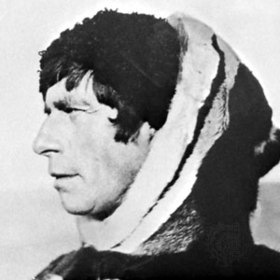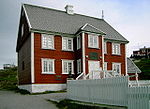Knud Rasmussen
Knud Johan Victor Rasmussen | |
|---|---|
 Knud Johan Victor Rasmussen | |
| Born | June 7, 1879 Jakobshavn (Ilulissat), Greenland |
| Died | December 21, 1933 (aged 54) Copenhagen, Denmark |
| Nationality | Greenlandic, Danish |
| Awards | Vega Medal (1919) |
| Scientific career | |
| Fields | Anthropologist |
Knud Johan Victor Rasmussen (June 7, 1879 – December 21, 1933) was a Greenlandic/Danish polar explorer and anthropologist. He has been called the "father of Eskimology"[1] and was the first European to cross the Northwest Passage via dog sled.[2] He remains well known in Greenland, Denmark and among Canadian Inuit.[3]
Early years

Rasmussen was born in Jakobshavn (now Ilulissat), Greenland, the son of a Danish missionary, the vicar Christian Rasmussen, and an Inuit- Danish mother, Lovise Rasmussen (née Fleischer). He had two siblings, including a brother, Peter Lim. Rasmussen spent his early years in Greenland among the Kalaallit (Inuit) where he learned from an early age to speak the language (Kalaallisut), hunt, drive dog sleds and live in harsh Arctic conditions. "My playmates were native Greenlanders; from the earliest boyhood I played and worked with the hunters, so even the hardships of the most strenuous sledge-trips became pleasant routine for me."[4] He was later educated in Lynge, North Zealand, Denmark. Between 1898 and 1900 he pursued an unsuccessful career as an actor and opera singer.[3][5]
Career
He went on his first expedition in 1902–1904, known as The Danish Literary Expedition, with Jørgen Brønlund, Harald Moltke and Ludvig Mylius-Erichsen, to examine Inuit culture. After returning home he went on a lecture circuit and wrote The People of the Polar North (1908), a combination travel journal and scholarly account of Inuit folklore. In 1908, he married Dagmar Andersen.
In 1910, Rasmussen and friend Peter Freuchen established the Thule Trading Station at Cape York (Uummannaq), Greenland, as a trading base.[3][6] The name Thule was chosen because it was the most northerly trading post in the world, literally the "Ultima Thule".[4] Thule Trading Station became the home base for a series of seven expeditions, known as the Thule Expeditions, between 1912 and 1933.
The First Thule Expedition (1912, Rasmussen and Freuchen) aimed to test Robert Peary's claim that a channel divided Peary Land from Greenland. They proved this was not the case in a remarkable 1,000-km journey across the inland ice that almost killed them.[3] Clements Markham, president of the Royal Geographic Society, called the journey the "finest ever performed by dogs."[7] Freuchen wrote personal accounts of this journey (and others) in Vagrant Viking (1953) and I Sailed with Rasmussen (1958).

The Second Thule Expedition (1916–1918) was larger with a team of seven men, which set out to map a little-known area of Greenland's north coast. This journey was documented in Rasmussen's account Greenland by the Polar Sea (1921). The trip was beset with two fatalities, the only in Rasmussen's career,[3] namely Thorild Wulff and Hendrik Olsen. The Third Thule Expedition (1919) was depot-laying for Roald Amundsen's polar drift in Maud.[3] The Fourth Thule Expedition (1919–1920) was in east Greenland where Rasmussen spent several months collecting ethnographic data near Angmagssalik.[3]
Rasmussen's "greatest achievement"[3] was the massive Fifth Thule Expedition (1921–1924) which was designed to "attack the great primary problem of the origin of the Eskimo race."[4] A ten volume account (The Fifth Thule Expedition 1921-1924 (1946)) of ethnographic, archaeological and biological data was collected, and many artifacts are still on display in museums in Denmark. The team of seven first went to eastern Arctic Canada where they began collecting specimens, taking interviews (including the shaman Aua, who told him of Uvavnuk), and excavating sites. Rasmussen left the team and traveled for 16 months with two Inuit hunters by dog-sled across North America to Nome, Alaska - he tried to continue to Russia but his visa was refused.[3] He was the first European to cross the Northwest Passage via dog sled.[2] His journey is recounted in Across Arctic America (1927), considered today a classic of polar expedition literature.[3] This trip has also been called the "Great Sled Journey" and was dramatized in the Canadian film The Journals of Knud Rasmussen (2006).
For the next seven years Rasmussen traveled between Greenland and Denmark giving lectures and writing. In 1931, he went on the Sixth Thule Expedition, designed to consolidate Denmark's claim on a portion of eastern Greenland that was contested by Norway.[3]
The Seventh Thule Expedition (1933) was meant to continue the work of the sixth, but Rasmussen contracted pneumonia after an episode of food poisoning attributed to eating kiviaq,[citation needed] dying a few weeks later in Copenhagen at the age of 54.
Honors
Knud Rasmussen Land, Cape Knud Rasmussen, Knud Rasmussen Land, Knud Rasmussen Glacier in far NW Greenland, Knud Rasmussen Glacier in SE Greenland, as well as the Knud Rasmussen Range in W Greenland are named after him.[8] He was awarded an Honorary Fellowship from the American Geographical Society in 1912, and its Daly Medal in 1924.[9] The Royal Geographical Society awarded him their Founder's Gold Medal in 1923[10] and the Royal Danish Geographical Society their Hans Egede Medal in 1924.[11]
He was made honorary doctor at the University of Copenhagen in 1924.
Notes
- ^ Jean Malaurie, 1982.
- ^ a b Alley, Sam. "Knud Johan Victor Rasmussen". Mankato: Minnesota State University. Archived from the original on 12 October 2010. Retrieved 23 November 2015.
{{cite web}}: Unknown parameter|deadurl=ignored (|url-status=suggested) (help) - ^ a b c d e f g h i j k Elizabeth Cruwys, 2003.
- ^ a b c Knud Rasmussen, 1927, Across Arctic America, Introduction.
- ^ "Life and history:". ilumus.gl. Retrieved 2008-01-06.
- ^ Freuchen, Dagmar (1960). Peter Freuchen's Adventures in the Arctic. New York: Messner. p. 21.
{{cite book}}:|access-date=requires|url=(help) - ^ Clements Markham, 1921
- ^ "Knud Rasmussen Land". Mapcarta. Retrieved 24 April 2016.
- ^ "American Geographical Society Honorary Fellowships" (PDF). amergeog.org. Retrieved 2009-03-02.
- ^ "List of Past Gold Medal Winners" (PDF). Royal Geographical Society. Retrieved 24 August 2015.
- ^ (in Danish)
Bibliography
Primary
- Rasmussen, Knud (1908). The People of the Polar North. Edited by G. Herring.
- Rasmussen, Knud (1921). Greenland by the Polar Sea: The Story of the Thule Expedition from Melville Bay to Cape Morris Jesup. Transl. by Asta and Rowland Kenny. Published by W. Heinemann.
- Rasmussen, Knud (1927). Across Arctic America: Narrative of the Fifth Thule Expedition.
- Rasmussen, Knud (author), Cole, Terrence (introduction, editor). Across Arctic America: Narrative of the Fifth Thule Expedition. University of Alaska Press; Reprint edition (February 1999). ISBN 0-912006-93-5 (hard) ISBN 0-912006-94-3 (paper).
- Rasmussen, Knud (1946–52). The Fifth Thule Expedition, 10 volumes. Published posthumously by fellow expeditioners.
Secondary
- Bown, Stephen R. White Eskimo: Knud Rasmussen's Fearless Journey into the Heart of the Arctic (Da Capo, 2015). xxvi, 341 pp.
- Cruwys, Elizabeth (2003). "Rasmussen, Knud (1879-1933)", in Literature of Travel and Exploration: An Encyclopedia, volume 3. ISBN 1-57958-247-8
- Malaurie, Jean (1982). The Last Kings of Thule: With the Polar Eskimos, as They Face Their Destiny, trans. Adrienne Folk.
- Markham, Clements R. (1921). The Lands of Silence: A History of Arctic and Antarctic Exploration. Cambridge University Press.
Online
- Rasmussen, Knud (collector), Worster, W. (editor, translator). Eskimo Folk Tales. London: Gyldendal, etc. 1921. Scanned, illustrated at Internet Archive
- Rasmussen, Knud. Across Arctic America: Narrative of the Fifth Thule Expedition. New York: G. P. Putnam's Sons, 1927. Scanned, illustrated, at Internet Archive.
External links
- Knud Johan Victor Rasmussen, biography by Sam Alley. Minnesota State University.
- Knud Rasmussen College, Greenland.
- Knud Rasmussens House, Denmark
- The Knud Rasmussen society in Denmark
- Works by Knud Rasmussen at Project Gutenberg
- Works by or about Knud Rasmussen at the Internet Archive
- Knud Rasmussen at Find a Grave
- The 5th Thule Atlas
